|
|
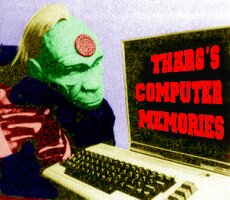 | Tharg's Computer Memories
A brief history of 2000AD computer games by Leigh
Shepherd
When Rebellion bought 2000AD, you could
be forgiven for being surprised - a computer games
company taking over a comic? That said, 2000AD and
computer games have a lengthy history, with a long line
of games based on 2000AD characters stretching back
almost two decades.
Even before any characters
had made the jump from page to pixel, the comic had run
features on the burgeoning computer games industry.
‘Tharg’s Mighty Micro Pages’ was a
semi-regular feature that ran reviews of games and
printed short programs submitted by readers. Ex-editor
Richard Burton worked on the short lived Big K
magazine (which was promoted with adverts drawn by Ian
Gibson) while Kelvin Gosnell, another ex-editor, wrote a
comic strip for Crash and Zzap!64 magazines
called "The Terminal Man". He even wrote an
article for the 1985 Christmas special edition of Zzap!64
called "2000AD speak", which outlined the
origin of 2000AD words such as grexnix and Zarjaz. The
introduction to the article made the link between
2000AD’s audience and the new breed of computer
gamers and programmers; "Judging from Zzap’s
mailbag, a goodly number of you do savvy 2000AD-speak.
Letters to Zzap talk quite frequently of Zarzog (sic)
games or scrotnig playability. These two
particular adjectives seem to be the most popular and
have even found their way on to software house press
releases."
|
 |
It wasn’t
until 1984 that Tharg decided that the primitive computer
technology had advanced sufficiently to bring his
characters to life. The first game came about through
unusual circumstances, as Mark Eyles, then Creative
Director for Quicksilva explains; "I wrote to 2000AD
while working at Quicksilva asking for a picture of Tharg
to help give us more thrill power while working on games.
The then editor, Richard Burton, wrote back, sending
through a signed photo of Tharg. In an accompanying
letter he revealed that he was a fan of our games.
I went up to see him to talk about
licensing a 2000AD character. My first choice was Dredd,
but all the rights for Dredd were tied up with the film,
so I went for my second choice - Strontium Dog."
|
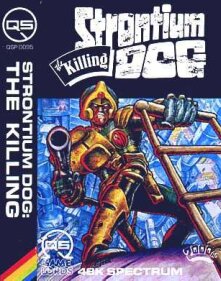 |
Unusually, the Spectrum and Commodore
64 versions of the games were completely different, with
Spectrum owners getting "The Killing" (an
adaptation of the strip from progs 350-359) and Commodore
owners getting "The Death Gauntlet". Eyles
explains the reason for this: "(Quicksilva) worked
on Strontium Dog: The Death Gauntlet. By enormous
coincidence as we were getting ready to launch Death
Gauntlet we were approached by some guys who had
produced a Strontium Dog game for the Spectrum.
They hadn't thought about licensing the character before
producing their game! So we said great, we'll publish it
for you!" Strontium Dog:
The Killing was a top down affair, where you
manoeuvred Alpha from room to room. The idea was to build
up your bounty by clearing each room of criminals, while
avoiding being shot or touching the glowing hazards that
littered the screens. As in the original story,
Electroflares could be used to clear out medi-centres,
and other characters from the strip such Barnak Spraks
and Steelkreeg the android made appearances.
By contrast, Strontium Dog: The
Death Gauntlet saw Alpha stranded on a hostile
planet, fighting his way to a rendezvous with Wulf and
the Gronk. A sideways scrolling shoot ‘em up, Alpha
was propelled across the surface of the planet and had to
avoid both obstacles and hostile aliens. Again, Alpha
could use electroflares (this time to temporarily stun
opponents) as well a limited number of time bombs to
fling himself out of danger.
Both games benefited from the
involvement of Ezquerra, who produced two of his finest
images of Alpha for the cover art. Mark Eyles brush with
2000AD would not end with these games. He later wrote
Wireheads for 2000AD and is now Head of Design at
Rebellion, where he also helps out with the 2000ADonline
website and has a hand in editing the graphic Novels.
|
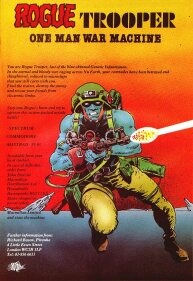 |
It would not be until 1986 that other
2000AD characters would feature in their own games.
Piranha’s Rogue Trooper (programme by Design
Design) brought us an isometric Nu Earth, while Melbourne
House’s Judge Dredd (programme by Beam
Software) featured a platform based gameplay that would
set the template for the next decade of Dredd games. Both
games struggled with the job of bringing the unique
features of the comic to life with varying degrees of
success. Ian Wareing, Programmer for Design Design, realised
the task set him: "the main part of my job was to
portray Rogue Trooper as accurately as possible.
Rogue freaks will recognise him immediately.". Certainly many elements of the strip are
present, with Rogue marching through ruins, deserts and
glass zones, accompanied by a running commentary from the
bio-chips. However, the game as originally envisaged by
the programmers appears to have had even greater
ambitions. In early previews there was talk of Rogue
encountering Bland and Brass and being affected by
Dreamweaver gas. In addition, Rogue was to have been able
to don a disguise, and hijack vehicles, but sadly none of
these elements made it into the eventual release.
|
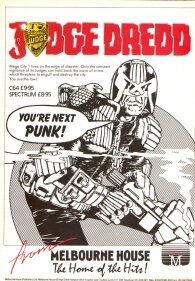 |
The Judge Dredd game sees you
attempting to keep the crime level down in Mega City one.
The player first chooses which crime to investigate from
the sector map, and then takes to the streets to hunt
down his quarry. The Judge’s Lawgiver is fully
equipped with all six types of ammo, and the player is
able to issue non lethal warnings to lesser perps in
order to make an arrest. Only when the crime rises above
tolerance does the game finish. A nice touch was the
instruction sheet, which was laid out as a ‘Judges
Manual’ - for example, section 2.6 states that
"Regulations allow the individual Judge to pause
during his or her current mission. Approved procedure to
pause is to press the F1 key.". These two games are probably the easiest to
track down, both having been reissued as budget titles a
few years after the initial release. In a subsequent
multi-game budget release from Alternative Software
"4 in 1 MegaHeroes", The Rogue game was
relabelled "Space Trooper" and featured the
eponymous hero: "the sole survivor of the Yablon
Massacre" whose "driving urge is to find and
expose the traitor responsible for the slaughter of his
comrades". Hmmm, sounds familiar……
|
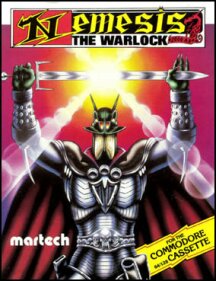 |
1987 brought Nemesis The Warlock,
again for the Spectrum and Commodore 64 formats, in an
atmospheric version programmed by Creative Reality and
published by Martech. Another platformer, this game had
Nemesis battling Terminators and their reanimated
corpses, armed only with Excessus, a gun with limited
ammunition and his ability to spit acid fireballs. Before
moving from each screen Nemesis has to dispatch a set
number of Terminators and find the correct place to exit.
A neat twist that suited the macabre nature of the strip
was the ability to pile up the dead Terminators’
bodies and use them to gain access to higher platforms. |
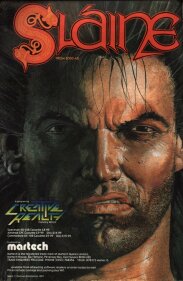 |
Martech followed this up a few months
later with a Slaine game, again by Creative
Reality. In their design notes they expressed the
difficulties in realising the galaxies greatest
characters in 8-bit form: "The idea for the design
of the (Slaine) game came about as a result of the
response to "Nemesis the Warlock". This
game was very well received but 2000AD devotees felt that
it did not go far enough to capture the true spirit of
Nemesis, as portrayed in the comic. People asked
"where’s Grobbendonk?"; "What about
the ABC Warriors?" ;etc. We realised that for Slaine
an entirely different approach was required.". Certainly the game, while ostensibly a text
based adventure with illustrative graphics, featured a
unique interface for the player. Rather than type in the
actions the player wished Slaine to take, a cursor was
used to select instructions as they drifted across the
screen. These could be strung together to make commands
and were an attempt to replicate the thought processes of
the character. Creative Reality also got help from Pat
Mills (credited as helping with "story and
text") and Glenn Fabry provided a striking original
cover for the game, as well as producing a stunning cover
and internal illustrations for the October ‘87
edition of Computer and Video Games.
|
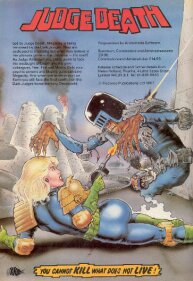 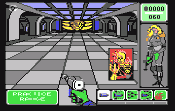
|
1988 promised even more 2000AD games.
In the December ‘87 editions of Crash and Zzap!64
magazines, Piranha ran a 16 page advert for the Judge
Death game, that reprinted the first two episodes of
the Anderson strip from progs 416 and 417. This first
person perspective target shooting game from
Budapest-based programming team Hobbyte, allowed the
player to step into the boots of Anderson as she tries to
stop the Four Dark Judges rampaging through the streets
of Mega City 1. In the news section of Crash in
that issue, Piranha stated they had already started work
on a Halo Jones adaptation, and were considering
an Ace Trucking game. The Halo Jones game
was to have been set on the Hoop and based on the first
Book of Moore and Gibson’s classic. "The basic
idea is that Halo Jones goes shopping" said
programmer Mike Lewis. The game was to have featured a
map randomiser, so that no two games were exactly the
same, and was due for release in Easter ’88. It was not to be, as Piranha folded before any
of these games could be released. However, the Death game
was in an advanced state and is available on emulators in
both its original form, and as the reworked "Horror
City", with amended graphics.
By 1990, the 16 bit Atari
ST and Commodore Amiga machines had become the new rivals
at the forefront of gaming. Both Dredd and Rogue were to
appear in quick succession on this format (the Dredd game
was also produced for C64 and Spectrum).
|
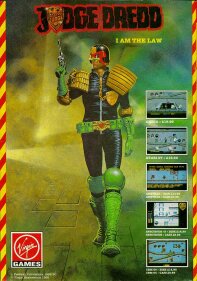 |
The Judge Dredd game from
Virgin was another sideways platformer (this time with
the benefit of scrolling screens), that borrowed heavily
from the earlier Melbourne House release (the game ends
only when the crime rate becomes untenable, Dredd can
arrest lesser perps rather than shoot them, etc). Each
level is based loosely on a classic strip (for example
fatties in first level, then devolving citizens in
Charles Darwin block in the second) though conforms to
the same set up - locate and shut down food
dispensers/air vents/water supplies, etc. while fighting
off and arresting criminals. The game did allow the
player to drive the Lawmaster (both as a means of
negotiating the main levels, and as part of sub-levels at
the end of each stage of the game), but the Lawgiver had
only three shots; standard, heat seeking and for some
reason a "high-powered laser" shot. The game is
notable for featuring a cover by Dermot Power, predating
his first strip work for 2000AD by some months. The Rogue Trooper Game combined two
sideways scrolling levels bookending two ‘Space
Harrier’ style flying stages. Rogue must break out
of Nort captivity in the first stage, as well as gather
data on the identity of the Traitor General.
Commandeering a Nort craft for the infuriating second and
third levels (where success is dependent on the blind
selection of fuel and equipment that you are asked to
make at the start of the stage), Rogue arrives at a
Souther base. Here he has to deliver the information to
Souther command before the Norts overrun the base. The
instruction manual also included a massive 56 pages of
Rogue strip, reprinting his earliest adventures.
|
| |
After these two games,
everything went quiet until the Dredd film licence of
1995. This game was by Acclaim, whose name eagle eyed
earthlets will have seen scattered through the comics
pages throughout the early 90’s in 2000AD’s
only attempt at product placement. The programmer of the SNES version, Carl Muller,
wrote to the comic and explained that he had become a fan
of 2000AD while researching the game. "This is why
we extended the game beyond the movie, so we could put in
Chopper, the Gila Munja and the Dark Judges". The
game once again conforms to the sideways platforms and
ladders formula established by the very first Dredd game
from a decade earlier.
In 1997, a Judge Dredd light gun game
was produced by Gremlin for the Playstation. Perhaps the
most interesting aspect of this game was the inclusion of
FMV cut scenes, starring Richard Waters, the actor who
had been used to promote Dredd for some years prior to
the games release. Gremlin also hired Simon Bisley to
provide concept art and the cover.
|
| |
Other than a Dredd based
pinball game for the PC in 1998, there have been no more
releases based on 2000AD strips. Two years ago, Rebellion
bought 2000AD and with it all the licences to the
characters. Since then, work has continued on the Dredd
vs. Death first person shooter. There have also been
rumours and hints about other games high on the converson
hitlist, such as Rogue Trooper, Strontium Dog and
Slaine. Controversially,
the first game to be released under the 2000AD banner was
Gunlok. Not linked to a strip, there was for a
time suggestions that Gunlok might make the leap
to printed page. Since then a prequel to Rebellions
forthcoming game Wardog has appeared in the
Megazine, but we still have to wait until next year for
Rebellion’s first attempt at realising an
established 2000AD character as a game.
Until then, enjoy these retro blasts
from the past and ponder on the thrill power that was
squeezed out of machines that had less processing power
than the average toaster!
|
|

![]() Judge Dredd and 2000 AD © Rebellion A/S 2008.
Judge Dredd and 2000 AD © Rebellion A/S 2008.







